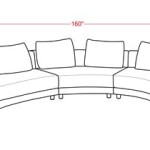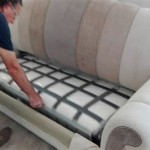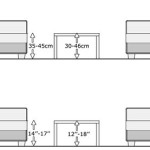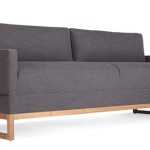How to Make Seat Covers for Your Sofa
Protecting your sofa and updating its appearance can be achieved with custom-made seat covers. Creating your own seat covers allows for a personalized touch, precise fit, and the opportunity to choose fabrics that complement your existing décor. This article provides a detailed guide on crafting seat covers for a sofa, covering the necessary materials, tools, and step-by-step instructions.
Gathering Materials and Tools
The first step in crafting sofa seat covers is to assemble the required materials and tools. This preparation ensures a smooth and efficient workflow throughout the project.
Fabric: The selection of fabric is crucial and depends on factors such as durability, aesthetics, and ease of maintenance. Durable options like canvas, denim, or upholstery-grade fabrics are recommended for high-traffic areas. Consider the fabric's weight; heavier fabrics generally offer better wear resistance. The required yardage will depend on the size of your sofa and the number of cushions you intend to cover. Accurately measure the cushions (length, width, and depth) and account for seam allowances (typically 1 inch on all sides) and potential pattern matching. Purchasing extra fabric is always prudent to avoid shortages due to miscalculations or errors during the cutting process.
Measuring Tools: Accurate measurements are the foundation of well-fitting seat covers. A flexible measuring tape is essential for capturing the contours and dimensions of the sofa cushions. A ruler or straight edge will aid in creating straight lines and ensuring precise cuts. Use tailor's chalk or a fabric marker to transfer measurements onto the fabric. These tools allow for clear and erasable markings, preventing errors during the cutting stage.
Cutting Tools: Sharp fabric scissors or a rotary cutter are necessary for clean and precise cuts. Fabric scissors should be specifically designed for cutting fabric, ensuring a smooth and even edge. A rotary cutter, used with a self-healing cutting mat, can be particularly useful for cutting long, straight lines. It's important to maintain sharp blades to prevent fraying or jagged edges, which can compromise the final result.
Sewing Machine: A sewing machine in good working order is essential for assembling the seat covers. Ensure that the machine is threaded correctly and that the tension is properly adjusted for the chosen fabric. A walking foot attachment can be beneficial when working with thicker or multiple layers of fabric, as it helps to feed the fabric evenly. Practice sewing on scrap fabric before starting the actual project to ensure proper stitch length and tension.
Sewing Supplies: Matching thread that complements the chosen fabric is crucial for creating a seamless and professional finish. Pins are essential for holding fabric pieces together before sewing, preventing shifting and ensuring accurate alignment. A seam ripper is a necessary tool for correcting any sewing mistakes. Needles appropriate for the fabric type should be used to prevent skipped stitches or fabric damage. Different needle sizes and types are available for various fabrics, so consult a sewing guide or fabric store professional for recommendations.
Other Supplies: Zippers or Velcro closures can be incorporated into the seat covers for easy removal and cleaning. Interfacing can be used to add structure and stability to certain areas, such as around zippers or along seams. Piping or trim can be added for decorative effect and to enhance the overall appearance of the seat covers. These optional supplies can elevate the design and functionality of the finished product.
Measuring and Cutting the Fabric
Accurate measuring and cutting are paramount to achieving a well-fitted and professional-looking seat cover. This stage requires careful attention to detail and precision.
Measuring the Cushions: Begin by measuring the length, width, and depth of each cushion. Measure along the seams if existing covers are being used as a template. For cushions without existing covers, measure the overall dimensions, taking into account any curves or irregularities. Add seam allowances (typically 1 inch on all sides) to each measurement. This will provide ample room for sewing and ensure a comfortable fit. Record all measurements accurately to avoid errors during the cutting process.
Creating a Pattern (Optional): If desired, create a paper pattern based on the cushion measurements. This pattern will serve as a template for cutting the fabric. Trace the cushion's shape onto a large sheet of paper, adding seam allowances. Cut out the pattern pieces and label them clearly to avoid confusion. Using a pattern can be particularly helpful for complex cushion shapes or when multiple identical covers are needed.
Laying Out the Fabric: Lay the fabric on a flat, clean surface. Ensure that the fabric is free of wrinkles or creases. If the fabric has a pattern, consider how the pattern will be aligned on each cushion cover. Pattern matching may require additional fabric. Pin the paper pattern to the fabric or, alternatively, use the measurements to directly mark the fabric with tailor's chalk or a fabric marker. Be precise and ensure that all lines are straight and accurate.
Cutting the Fabric: Carefully cut the fabric along the marked lines using sharp fabric scissors or a rotary cutter. Maintain a smooth, consistent cutting motion to avoid jagged edges. If using a rotary cutter, use a self-healing cutting mat to protect the work surface. Cut all necessary pieces for each cushion cover, including the top, bottom, and side panels. Label each piece clearly to avoid confusion during the sewing process.
Considerations for Curved Cushions: For cushions with curved edges, use a flexible measuring tape to accurately capture the curvature. Create a paper pattern that reflects the curved shape. When cutting the fabric, carefully follow the curved lines, using small, precise cuts to avoid distorting the fabric. Notches can be added along the curved edges to allow the fabric to conform more easily to the cushion's shape during sewing. Clipped seam allowances will also help reduce bulk and create a smoother curve.
Assembling and Sewing the Seat Covers
Once the fabric pieces are cut, the next step is to assemble and sew the seat covers. This stage requires careful attention to detail and precise sewing techniques.
Pinning the Fabric Pieces: Align the fabric pieces for each cushion cover, matching the edges carefully. Pin the pieces together, placing pins perpendicular to the seam line. Use plenty of pins to ensure that the fabric remains aligned during sewing. For curved seams, ease the fabric together by slightly stretching or gathering it as needed. Ensure the right sides of the fabric are facing each other.
Sewing the Seams: Using a sewing machine, sew the seams with a consistent seam allowance (typically 1 inch). Start and end each seam with a backstitch to secure the stitching and prevent unraveling. For curved seams, sew slowly and carefully, guiding the fabric smoothly under the needle. Regularly check the seam alignment to ensure that the fabric pieces are matching up correctly.
Installing Zippers or Velcro (Optional): If zippers or Velcro closures are desired, install them according to the manufacturer's instructions. Zippers are typically sewn along the back edge of the cushion cover, allowing for easy removal. Velcro can be attached to the edges of the cover and the corresponding edges of the sofa frame. Ensure that the zippers or Velcro closures are properly aligned and securely attached.
Adding Piping or Trim (Optional): If piping or trim is being added, sew it along the edges of the cushion cover before assembling the final seams. Position the piping or trim with the raw edge facing outward and the finished edge aligned with the edge of the fabric. Sew close to the piping or trim to secure it in place. Use a zipper foot if necessary to sew close to the piping without damaging the fabric.
Finishing the Seams: Once all seams are sewn, finish the raw edges to prevent fraying. This can be done using a serger, a zig-zag stitch on a sewing machine, or by binding the edges with bias tape. Finishing the seams adds durability and a professional touch to the finished product. Trim excess seam allowance to reduce bulk.
Turning and Fitting the Cover: Turn the cushion cover right-side out and carefully fit it onto the cushion. Ensure that the cover fits snugly and that all seams are properly aligned. Make any necessary adjustments to the seams or closures to achieve a perfect fit. If the cover is too tight, consider adding small gussets or darts to provide more room. If the cover is too loose, take in the seams slightly.
Final Touches: Once the cover fits properly, press the seams with an iron to create a crisp, professional finish. Steam ironing can help to remove any wrinkles or creases in the fabric. Inspect the cover for any loose threads or imperfections and trim them as needed. The completed seat cover is now ready for use.
By following these detailed instructions, individuals can create custom-made seat covers that perfectly fit their sofas and enhance the overall aesthetic of their living spaces. Careful planning, precise measurements, and attention to detail are key to achieving a successful and satisfying outcome.

Easy Diy Drawstring Seat Cushion Cover

Diy Full Set Sofa Cover Making At Home Part 1

Easy Diy Drawstring Seat Cushion Cover

How To Make Seat Cushions Covers By Tracing Platform Reupholster A Sofa Episode 3

How To Make Slipcovers Part 6
Make Your Own Loveseat Protector Storybook Woods

Covers For Sofa Seat Unique Home Decor Items Shorts

Easy To Make Remove Seat Covers Uplifting Mayhem

Tree Design Sofa Towel Jacquard Cover Fix Tight Anti Slip Cushion Seat On Decorate Living Room Easy Install Joom

How To Make A Sofa Cover Paano Gumawa Ng








